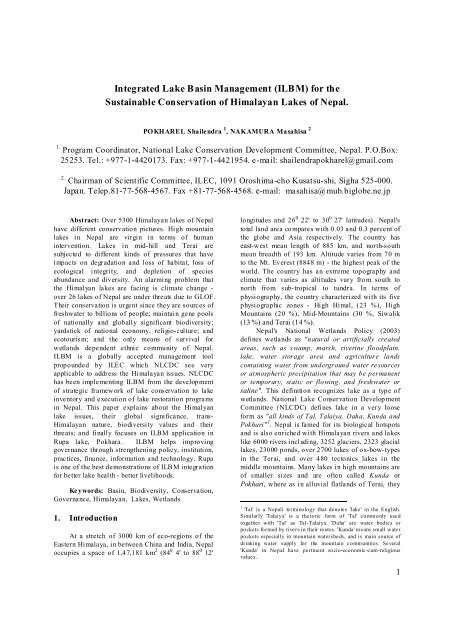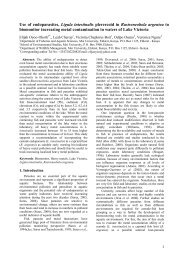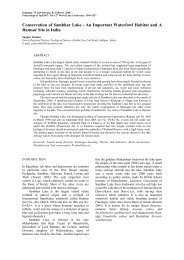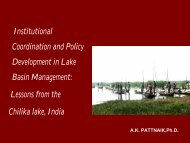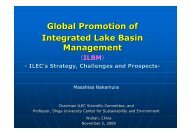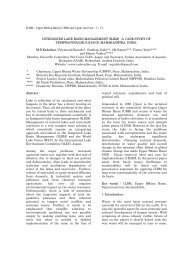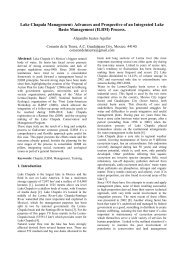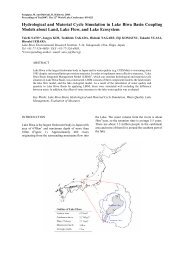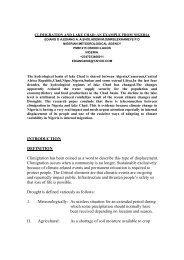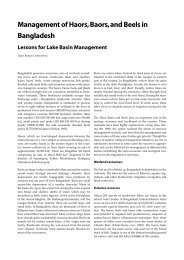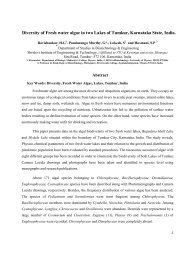Integrated Lake Basin Management (ILBM) - World Lake Database
Integrated Lake Basin Management (ILBM) - World Lake Database
Integrated Lake Basin Management (ILBM) - World Lake Database
You also want an ePaper? Increase the reach of your titles
YUMPU automatically turns print PDFs into web optimized ePapers that Google loves.
<strong>Integrated</strong> <strong>Lake</strong> <strong>Basin</strong> <strong>Management</strong> (<strong>ILBM</strong>) for the<br />
Sustainable Conservation of Himalayan <strong>Lake</strong>s of Nepal.<br />
1. Program Coordinator, National <strong>Lake</strong> Conservation Development Committee, Nepal. P.O.Box:<br />
25253. Tel.: +977-1-4420173. Fax: +977-1-4421954. e-mail: shailendrapokharel@gmail.com<br />
2. Chairman of Scientific Committee, ILEC, 1091 Oroshima-cho Kusatsu-shi, Sigha 525-000.<br />
Japan. Telep.81-77-568-4567. Fax +81-77-568-4568. e-mail: masahisa@mub.biglobe.ne.jp<br />
Abstract: Over 5300 Himalayan lakes of Nepal<br />
have different conservation pictures. High mountain<br />
lakes in Nepal are virgin in terms of human<br />
intervention. <strong>Lake</strong>s in mid-hill and Terai are<br />
subjected to different kinds of pressures that have<br />
impacts on degradation and loss of habitat, loss of<br />
ecological integrity, and depletion of species<br />
abundance and diversity. An alarming problem that<br />
the Himalyan lakes are facing is climate change -<br />
over 26 lakes of Nepal are under threats due to GLOF.<br />
Their conservation is urgent since they are sources of<br />
freshwater to billions of people; maintain gene pools<br />
of nationally and globally significant biodiversity;<br />
yardstick of national economy, religio-culture; and<br />
ecotouris m; and the only means of survival for<br />
wetlands dependent ethnic community of Nepal.<br />
<strong>ILBM</strong> is a globally accepted management tool<br />
propounded by ILEC which NLCDC see very<br />
applicable to address the Himalayan issues. NLCDC<br />
has been imple menting <strong>ILBM</strong> from the develop ment<br />
of strategic framework of lake conservation to lake<br />
inventory and execution of lake restoration programs<br />
in Nepal. This paper explains about the Himalyan<br />
lake issues, their global significance, trans-<br />
Himalayan nature, biodiversity values and their<br />
threats; and finally focuses on <strong>ILBM</strong> application in<br />
Rupa lake, Pokhara. <strong>ILBM</strong> helps improving<br />
governance through strengthening policy, institution,<br />
practices, finance, information and technology. Rupa<br />
is one of the best demonstrations of <strong>ILBM</strong> integration<br />
for better lake health - better livelihoods.<br />
Ke ywords: <strong>Basin</strong>, Biodiversity, Conservation,<br />
Governance, Himalayan, <strong>Lake</strong>s, Wetlands<br />
1. Introduction<br />
At a stretch of 3000 km of eco-regions of the<br />
Eastern Himalaya, in between China and India, Nepal<br />
occupies a space of 1,47,181 km 2 (84 0 4' to 88 0 12'<br />
POKHAREL Shailendra 1 , NAKAMURA Masahisa 2<br />
longitudes and 26 0 22' to 30 0 27' latitudes). Nepal's<br />
total land area co mpares with 0.03 and 0.3 percent of<br />
the globe and Asia respectively. The country has<br />
east-west mean length of 885 km, and north-south<br />
mean breadth of 193 km. Altitude varies from 70 m<br />
to the Mt. Everest (8848 m) - the highest peak of the<br />
world. The country has an extreme topography and<br />
climate that varies as altitudes vary fro m south to<br />
north from sub-tropical to tundra. In terms of<br />
physiography, the country characterized with its five<br />
physiographic zones - High Himal, (23 %), High<br />
Mountains (20 %), Mid-Mountains (30 %, Siwalik<br />
(13 %) and Terai (14 %).<br />
Nepal's National Wetlands Policy (2003)<br />
defines wetlands as "natural or artificially created<br />
areas, such as swamp, marsh, riverine floodplain,<br />
lake, water storage area and agriculture lands<br />
containing water from underground water resources<br />
or atmospheric precipitation that may be permanent<br />
or temporary, static or flowing, and freshwater or<br />
saline" . This definition recognizes lake as a type of<br />
wetlands. National <strong>Lake</strong> Conservation Develop ment<br />
Committee (NLCDC) defines lake in a very loose<br />
form as "all kinds of Tal, Talaiya, Daha, Kunda and<br />
Pokhari" Nepal is famed for its biological hotspots<br />
and is also enriched with Himalayan rivers and lakes<br />
like 6000 rivers including, 3252 glaciers, 2323 glacial<br />
lakes, 23000 ponds, over 2700 lakes of ox-bow-types<br />
in the Terai, and over 480 tectonics lakes in the<br />
middle mountains. Many lakes in high mountains are<br />
of smaller sizes and are often called or<br />
, where as in alluvial flatlands of Terai, they<br />
1 .<br />
Kunda<br />
Pokhari<br />
1 'Tal' is a Nepali terminology that denotes 'lake' in the English.<br />
Similarly 'Talaiya' is a rhetoric form of 'Tal' commonly used<br />
together with 'Tal' as Tal-Talaiya. 'Daha' are water bodies or<br />
pockets formed by rivers in their routes. 'Kunda' means small water<br />
pockets especially in mountain watersheds, and is main source of<br />
drinking water supply for the mountain communities. Several<br />
'Kunda' in Nepal have pertinent socio-economic-cum-religious<br />
values.<br />
1
are Pokhari . These Himalyana lakes are special<br />
because their origin follows diverse topography<br />
varying from subtropical to tundra climate; they are<br />
the Asian water towers; they support conventional<br />
agrarian socio-economy and complex ethnic society;<br />
and forms religio-cultural foundation for the Hindus,<br />
Buddhist and other communities. A total of Nepal's<br />
10 percent of indigenous and ethnic communities'<br />
population of Tharu, Mushar, Kewat, Dusadh,<br />
Mallah, Kumal, Majhi, Danuwar, Dhangar, Bantar,<br />
Darai, and Bote have sole dependence on Himalayan<br />
lakes/wetlands resources (Pokharel and Adhikari<br />
2009). Their sustainable conservation is urgent to<br />
serve human civilization since they are sources of<br />
freshwater supply to billions of people; they are the<br />
gene pools of nationally and globally significant<br />
biodiversity; they are sternum of national econo my,<br />
religio-culture; and ecotourism; and the only means<br />
of wetlands dependent ethnic community of Nepal.<br />
1.1 Nepal’s Himalyan lakes as the Ramsar site<br />
There are of 9 lakes of Nepal designated in the<br />
Ramsar list. They are: the Koshi Tappu (17,500 ha);<br />
Beeshazari Tal (3,200 ha); Jagdishpur Reservoir (225<br />
ha); Ghodaghodi Tal (2563 ha), Rara Tal (1,036 ha),<br />
Sheyphoksundo <strong>Lake</strong> (452 ha), Gokyo <strong>Lake</strong> Cluster<br />
(42.69 ha), Gosainkunda <strong>Lake</strong> Cluster (13.80 ha) and<br />
Mai Pokhari. These lakes contribute 0.05 percent of<br />
total coverage of lakes of the global significance.<br />
1.2 Potential Himalayan lakes of international<br />
significance<br />
Table 1 shows potential Himalayan lakes of Nepal of<br />
global significance. Others such lakes are Raja Rani<br />
of Morang district, Jata Pokhari of Dolakha district,<br />
and lake-cluster of Pokhara valley. Raja Rani is<br />
significant because of habitats of rare orchids,<br />
butterflies and origin place of an ethnic community<br />
Tab. 1 Potential Himalayan lakes of global importance<br />
Name Location Height Area<br />
(m) (ha)<br />
Tilicho lake Annapurna CA 4848 400<br />
Dudh Pokhari Dolpa 4633 32<br />
Jata Pokhari Upper Khimti 3500 24<br />
Jageshwar<br />
Kunda<br />
Trisuli basin 4380<br />
Surya Kunda Trisuli basin 4609 5<br />
Bhairab Kunda Trisuli basin 4261 17<br />
Panch Pokhari Makalu Barun NP 4971 NA<br />
called Dhimal. <strong>Lake</strong>-cluster of the Pokhara valley<br />
bears unique geography, and ecotourism. Chimdi<br />
lake in Sunsari district is biological hotspots for<br />
avifauna, amphibians and reptiles. Jata Pokhari is<br />
well famed for its religio-cultural values. Azingara<br />
lake in Kapilvastu is renowned for habitats of wild<br />
rice, fishes and amphibians.<br />
1.3 Trans-Himalyan lakes of Nepal<br />
River systems link Nepal with China, Bangladesh<br />
and India. For examples, Koshi, Gandaki, Karnali<br />
and Mahakali are perennial sources of water to<br />
downstream population of Nepal, India and<br />
Bangladesh. Any changes made in glacial features in<br />
the Himalaya would also impacts on ecological<br />
Tab.2 Trans-boundary Himalayan lakes of Nepal<br />
Name Location Height Area<br />
(m) (ha)<br />
Rara West Nepal 2990 1036<br />
Gosainkunda Langtang NP 4360 14<br />
Tilicho Annapurna CA 4848 400<br />
Sheyphoksundo Shephoksundo NP 3650 452<br />
Dudh Pokhari Dolpa 4633 32<br />
Jata Pokhari Upper Khimti 3500 24<br />
Jageshwar Kunda Trisuli basin 4380<br />
Surya Kunda Trisuli basin 4609 5<br />
Bhairab Kunda Trisuli basin 4261 17<br />
Gokyo Sagarmatha NP 4734 43<br />
Panch Pokhari Makalu Barun NP 4971 NA<br />
behavior of rivers therefore to the livelihoods of<br />
billion of people at downstrea m India, Bangladesh<br />
and Nepal. Many trans- Hi malayan lakes which are<br />
also the sources of rivers Nepal fall in north of Nepal<br />
and are close to the Tibet, their flow in south drains<br />
lesser mountains and mid hills is a common concern<br />
of India & Bangladeshl. Table 2 shows transboundary<br />
Himalayan lakes of Nepal. Scientific<br />
information of some lakes like Rara, Sheyphosundo,<br />
Gosainkunda and Gokiyo which also are the lakes of<br />
global significance is fairly available. However,<br />
comprehensive information requires exploring in<br />
remaining other lakes.<br />
1.4 Himalayan lake biodiversity in Ne pal<br />
It is believed that 25 percent of Nepal's vascular<br />
plant species are lake/wetland dependent. Of 246<br />
ende mic plants, about 26 species are considered as<br />
lake/wetland dependent (IUCN, 2004). Of 91<br />
nationally threatened plant species, 10 are<br />
lake/wetlands dependent including the Endangered<br />
Aconitum balangrense, Crateva unilocularis,<br />
Operculina turpethum; and, Vulnerable Alstonia<br />
scholaris, Butea monosperma, Neopicrorhiza<br />
scrophulariifolia, Valerina jatamansii, Piper longum,<br />
Panax pseudo-ginseng, and Delbergia latifolia. Four<br />
wetlands macrophytes - Spiranthes sinensis, Cyathea<br />
spinulosa, Sphagnum nepalensis, Pandanus<br />
nepalensis - are nationally endangered (Joshi and<br />
Joshi, 1991). Kobresia fissiglumis, K. gandakiensis,<br />
Pedicularis poluninii, and P. pseudoregelina from<br />
Gokyo, and 9 endemic species from Gosaikunda lake<br />
and bryophytes Sphagnum nepalense from the Mai<br />
Pokhari are reported endemic fro m different lakes.<br />
2
Of 207 mammals of Nepal, the key globally<br />
threatened mammals that are lake/wetlands<br />
dependents include the Critically Endangered Pygmy<br />
Hog ( Sus salvanius ), this species is believed to be<br />
extinct now; wild water buffalo ( Bubalus bubalis),<br />
one-horned rhinoceros ( Rhinoceros unicornis ) and<br />
elephant ( Elephas maximus);<br />
Vulnerable Indian<br />
smoothed-coated otter ( Lutrogale perspicillata ), and<br />
common otter ( Lutra lutra), fishing cat ( Prionailurus<br />
viverrinus ) and Barasingha ( Cervus duvaucelii ).<br />
Nepal documents 863 species of birds of which 193<br />
species are lake/wetlands dependent. As many as 39<br />
species of these are identified as threatened on a<br />
national level (Baral et al. 1996). Table 3 shows 12<br />
species of globally threatened wetlands birds.<br />
Tab. 3 Globally threatened Himalyan lake/wetlands<br />
dependent birds of Nepal<br />
Common Name Scientific Name Stat<br />
us<br />
Pink-headed Duck Rhodonessa<br />
caryophyllacea<br />
CE<br />
Greater-adjutant Leptoptilos dunius E<br />
Lesser Florican Sypheotides indica E<br />
Baikal Teal Anas farmosa<br />
V<br />
Swamp Francolin Francolinus gularis V<br />
Baer's Pochard Aythya baeri<br />
V<br />
Grey Pelican Pelecanus phuilippinensis V<br />
Sarus Crane Grus antigone<br />
V<br />
Indian Skimmer Rynchops albicollis V<br />
Black-necked<br />
Crane<br />
Grus nigricollis<br />
V<br />
Lesser Adjutant Leptoptilos javanicus V<br />
Band-tailed<br />
Eagle<br />
Fish Haliaeetus leucoryphus V<br />
Of total 185 species of fishes of Nepal, 8 are<br />
ende mic. Of this, 27 species are reported to be<br />
nationally threatened including Endangered Sahar<br />
( Tor putitora ), Jalkapoor ( Clupisoma garuwa, Ompak<br />
bimaculatus); Vulnerable Katle ( Neolissocheilus<br />
hexagonolepis ), Patharchatti (Chagunius chagunio ),<br />
Zebra ( Danio rerio), Asala ( Schizothorax<br />
richardsonii ), Bucche Asala ( S. plagiostomus ),<br />
Chuche Asala ( Schizothoraicthys progastus ),<br />
Rajabam ( Anguilla bengalensis ); and 17 species<br />
listed as Rare. Similalry, Himalyan lakes are habitats<br />
for several herpetofauna including a primitive<br />
amphibian Himalayan Warty Newt ( Tylototricton<br />
verrucosus ), type locality species Lekali Khashare<br />
( Bufo himalayanus ), and ende mic species Jhikre<br />
Bhayguto ( Limnonetes nepalensis ). A little is known<br />
about butterfly diversity, though 64 species of<br />
butterflies including an endemic sub-species<br />
Parnassius epaphus and suspected species<br />
Mesoacidalia clara shieldsii to be endemic are<br />
reported from the vicinity of Rara (Khanal 2007).<br />
1.5 Threats to the Himalyan lakes of Nepal<br />
High mountain lakes in Nepal are virgin in<br />
terms of human intervention. However, lakes of the<br />
middle mountain and the Terai are subjected to<br />
different kinds of human and natural <strong>Lake</strong><br />
encroachment is heavily associated with human<br />
activities. Some other threats are:<br />
Draining out of water fro m lakes for<br />
dry-season crop irrigation is widespread in Nepal.<br />
Conversion of sites for aquaculture, road construction,<br />
solid-waste disposal, discharge of sediments,<br />
commercial and industrial development, dam<br />
construction, eutrophication, etc. nor mally accelerate<br />
soil reclamation process as in Phewa lake which<br />
shows a decrease in area from 10 km 2 (1956/57), to<br />
5.5 km 2 (’76) and 4.4 km 2 <strong>Lake</strong> drainage, se dime ntation and<br />
reclamation:<br />
(’98). There has been more<br />
than 50 percent reduction in area within 5 decades<br />
(JICA/SILT, 2002). 69 percent of the Terai wetlands<br />
are threatened by sedimentation.<br />
Habitat fragme ntation and deforestation:<br />
Fate of lakes depends upon fate of forests.<br />
Settle ments and agriculture fields in mid-hills and<br />
Terai are made available at the cost of clearing<br />
forests that also has survival impacts on lakes..<br />
Forests connectivity decreases with increased habitat<br />
fragmentation, thereby creating barriers to wildlife<br />
move ments; decreasing safety; reducing food<br />
availability; and enhancing poaching.<br />
Hydro-power development: Hydropower<br />
developments have several positive socio-economic<br />
impacts on the livelihoods; it may have some<br />
consequences on the formation of new lakes. Some<br />
anecdotal evidences - particularly in river basins<br />
(Koshi, Karnali, Mahakali) - showing ecological<br />
impacts of hydropower dams on reducing viable<br />
population of aquatic flora,<br />
fishes and ungulates.<br />
Nepal has 15 ungulate species dependent on<br />
lake/wetlands. Koshi Tappu, the only site with a<br />
viable population of Asian Wild Buffalo, has lost<br />
over half of its endemic ungulate species. Dam once<br />
combined with unregulated grazing, over fishing,<br />
deforestation, expansion of settlements, solid waste<br />
and sewage disposal, water harvest etc., further<br />
aggravate impacts on ecological integrity of lakes.<br />
Irrigation:<br />
Himalyan lakes are comparatively<br />
smaller water bodies that favor short-cycle irrigation<br />
needs, and require much time to refill water volume.<br />
However, unregulated irrigation alters micro-climate<br />
of lake ecosystem by sudden and frequent fluctuation<br />
of water che mistry. Conversion of the Chimdi lake<br />
has displaced some 200 fisheries family, and has<br />
questioned upon the survival of many potter<br />
communities (Gachhadar et al.<br />
2004). Once<br />
productive agriculture and marshy fields around<br />
3
Begans after dam construction is subjected to rapid<br />
conversion into dense suburb and semi-co mmercial<br />
areas, and high density population of eel fish is no<br />
more in existence.<br />
An estimated 2,600 tons<br />
of pesticides and 1.15 million tons of chemical<br />
fertilizers are dumped annually in the Ganges river<br />
system (IUCN 2004). Agriculture-run-off affected<br />
69 percent of lake/wetlands of Nepal's Terai. Impacts<br />
are bio-accumulation in higher-level animals leading<br />
to high concentration of toxic products causing death,<br />
sub-lethal effects and reduce reproductive capabilities<br />
(Pesticide poisoning led 300 people admitted to 10<br />
hospitals in 1992); widespread occurrence of<br />
Epizootic Ulcerative Syndrome, a disease caused by<br />
the fungus in fishes causing<br />
their mortality in Koshi Tappu (1983) and<br />
Ghodaghodi lake (1998); lake conversion from<br />
mesotrophic to eutrophic in Koshi Tappu; natural<br />
succession aggravated by overgrowth of macrophytes<br />
like water and as commonly seen in<br />
many lakes of the Terai and mid-hills.<br />
Himalyan lakes in urban and<br />
sub-urban are commonly treated as sink for the<br />
disposal of untreated domestic sewerage, septic tanks<br />
and effluents. Media reports on concurrence of<br />
chronic diarrhea and dysentery in the Terai often<br />
caused by colifor m bacteria. Over 100 numbers of<br />
toilets directly exposed into holy lakes of Janakpur -<br />
the Ganga Sagar and Dhanusha Sagar. The Phewa<br />
lake is reported to have 8X10 6 Agriculture run-off:<br />
Aphanomyces invadans<br />
Hyacinth Trapa<br />
Sewege Disposal:<br />
coliform per 100 ml<br />
(Khatiwada 2008).<br />
Fishing: The trend of fish poisoning with<br />
Thiodine and Phoret is widespread in the Terai<br />
including Koshi Tappu and Ghodghodi lake. Other<br />
mal-practices for fishing include elctro-fishing, use of<br />
small-mesh nets, draining out of water, and use of<br />
explosives. Such practices have caused a mass<br />
killing of aquatic fauna as well as affected food chain<br />
of ecosystem. For example, over-fishing in the Rupa<br />
and Begnas lakes declined the population of sahar<br />
( Tor spp.).<br />
Grazing: Himalyans lakes are subjected to open<br />
grazing for yaks, sheep and goats around in<br />
Damodarkunda, Gokyo, Gosainkunda, (Karki et al<br />
2005, Karki 2007, Shrestha 2005). Over 12,600 cattle<br />
are recorded grazing along shoreline forests of the<br />
Ghodaghodi lake and so me 15,000 to 20,000 in<br />
Koshi Tappu, every day. Impacts of over-grazing in<br />
lake shores have resulted soil erosion and high inputs<br />
of nitrogenous nutrients, eutrophication and overgrowth<br />
of aquatic macrophytes. Overgrazing also<br />
correlates with livestock health due to poor nutrients,<br />
inadequate food supply and high population pressure,<br />
making livestock exposed to diseases like liver fluke<br />
associated with marshland snails. Such disease when<br />
transmitted as epide mics to wild ungulate causes<br />
extinction of species 2 (IUCN, 2004).<br />
Climate Change: In Nepal, war ming rates<br />
increases progressively with elevations (Liu and<br />
Chen 2000; Shrestha et al. 1999). High war ming<br />
causes rapid deglaciation that alters hydrological<br />
regime of the river basins such as increase in floods<br />
and drought frequency and magnitude; so me time<br />
formation of glacial lakes in the open area around<br />
exposed end moraines; and increases vulnerability of<br />
glacial lakes to GLOF. Nepal already faced 25 GLOF<br />
in the past (Shrestha, 2007), and 26 glacial lakes have<br />
potential threats of the GLOF including the Tsho<br />
Rolpa (largest glacial lakes of Nepal grew from the<br />
area of 0.23 km 2 in 1957 to 1.76 km 2 in 2006) and the<br />
Imja Tsho. Similarly, climate change pushes forest<br />
line towards polar region and their composition and<br />
extinction of species, including bird species (Baral<br />
2002). Tropical wet forests and warm temperate rain<br />
forests would disappear, and cool temperate<br />
vegetation would turn to warm temperate vegetation.<br />
With the marginal increase in temperature may<br />
prolong dry-crop period in the Terai that may<br />
demand more water for irrigation at the cost of<br />
increased risk on lake conversion and loss of aquatic<br />
biodiversity.<br />
2. Conserving the Himalyan lakes of<br />
Nepal<br />
<strong>Lake</strong> conservation gradually evolves in Nepal<br />
along with the issues of forest and biodiversity<br />
conservation. Nepal brought all forests under its<br />
suzerainty during the first three five-year plans<br />
(1956-1971) in which high emphasis were given to<br />
improve infrastructure development (Sharma et al.,<br />
2004). <strong>Lake</strong>s conservation was least concerned until<br />
this period. A notion of environmental degradation<br />
was realized first time with the formation of new<br />
Moore islands in the Bay of Bengal. This concern<br />
was high since silt load transported to the Bay was<br />
evidenced at a high cost of landslides, erosions and<br />
floods associated with intense deforestation in Nepal.<br />
Hence, from 1972 to 1978, Nepal had next priority on<br />
forest management to address environment issues<br />
through first national forestry plan (1976) and<br />
community forestry (1978). This period was<br />
important in Nepal because it became a party of the<br />
Ramsar in 1972 and established its first Ramsar site.<br />
An extent of progresses Nepal made in<br />
conservation is guided through its commitment in<br />
international conventions and treaties like Ramsar<br />
2 Population of Asian Wild Water Buffalo in the Royal Chitwon<br />
National Park in the early 1960s may have become extinct due to<br />
diseases transmitted by domestic cattle and buffaloes brought in<br />
by immigrants settling around the park areas.<br />
4
(1972); Convention on Protection of Wildlife and<br />
Cultural Heritage (1972); Convention on<br />
International Trade of Endangered Species (1973);<br />
CBD (1992); and Convention on Climate Change. As<br />
responding to these conventions, Nepal developed<br />
and implemented several policies and programs. <strong>Lake</strong><br />
conservation for mally begins in Nepal from 1976<br />
with establishment of the Koshi Tappu Wild Life<br />
Reserve. Otherwise, issues of lake remained<br />
completely ignored until staging of Nepal<br />
Biodiversity Strategy (2002) which first time pledged<br />
for the need of unified national wetland policy and<br />
legislation. Consequently, National Wetlands Policy<br />
(2003) came into effect as a keen response to<br />
conserve lake/wetlands resources wisely and<br />
sustainably with a successive formation of National<br />
<strong>Lake</strong> Conservation Development Committee in 2007.<br />
This is the only government institution aiming to<br />
coordinate national and international bodies;<br />
formulate and implement policies and programs; and<br />
build national and international partnership with<br />
respect conserving Himalayan lakes of Nepal.<br />
2.1 <strong>ILBM</strong> initiative in the sustainable<br />
conservation of Himalayan lakes of Nepal<br />
<strong>ILBM</strong> is a comprehensive management tool that<br />
advocates on lake governance. It has six induction<br />
governance pillars i.e.,<br />
institutions, policies,<br />
participation, technology, information and finance.<br />
Integration of these components fairly harmonizes<br />
lake issues. Since 1990s, Nepal has been practicing<br />
management of forest, pasturelands, watersheds and<br />
water through integrated approach by involving local<br />
people and institution.<br />
Better experiences<br />
from these sectors<br />
could be a value<br />
addition on <strong>ILBM</strong> to<br />
address the issues of<br />
Himalayan lakes. For<br />
this cause, NLCDC<br />
has been working<br />
with Japan based<br />
International <strong>Lake</strong><br />
Environment<br />
Committee (ILEC) since 2007. ILEC has been<br />
facilitating NLCDC to convene its lake conservation<br />
cases in international forum; enabling it to undertake<br />
assessment of the Himalyan lake conservation;<br />
providing technical inputs and guidance; and<br />
enhancing technical capacities. In May 2009,<br />
NLCDC had influenced CAP-Net workshop<br />
organized by Bangladesh Center for Advance Studies<br />
(BCAS) with an outcome of establishing the South<br />
Asian Forum for <strong>Integrated</strong> Wetlands Conservation.<br />
In August 2009, ILEC in collaboration with Indian<br />
Association of Aquatic Biodiversity had NLCDC to<br />
share its strengths in a sequence meeting in Bhopal,<br />
Udayapur, Ajmer and Jaipur.<br />
In a process of integrating <strong>ILBM</strong>, NLCDC has<br />
completed a preliminary reviewing of the status of<br />
Himalayan lakes with the finding of 5300 lakes in<br />
Nepal, now ready to conduct field inventory to verify<br />
the validity. NLCDC would apply lake brief<br />
guideline adopted by ILEC with a little modification<br />
on it for the purpose of lake inventory. A national<br />
level core group of lake experts has been formed and<br />
operational to provide technical inputs for lake<br />
conservation programs. Development of strategic<br />
plan for the sustainable conservation and wise use of<br />
lakes has entered to the district level of consultation<br />
process in collaboration with IUCN Nepal, National<br />
Counsel for Science and Technology and National<br />
Trust for Nature Conservation. Further, it has<br />
extended technical and financial supports to restore<br />
and conserve habitats of over 50 representative lakes<br />
in different locations within the Nepal's geography. A<br />
scientific study for designating lake-cluster of<br />
Pokhara valley in the Ramsar list is in a steady<br />
progress with a financial assistance of SGP/Ramsar,<br />
this initiative would add contribution to Ramsar<br />
objective with a count of 10 th Ramsar site in Nepal.<br />
NLCDC has been playing an intermediary role<br />
between Action in Mountain Communities (AMC)<br />
and SGP/UNDP to integrate <strong>ILBM</strong> in an initiative of<br />
Community Safeguarding Rupa <strong>Lake</strong> in Pokhara.<br />
Here in this article, authors have made efforts to<br />
explain how six pillars of <strong>ILBM</strong> have been integrated<br />
in addressing the issues of Rupa lake based on<br />
cumulative impacts of different programs<br />
imple mented by different institutions.<br />
2.2 <strong>ILBM</strong> in Rupa lake conservation, Pokhara<br />
Rupa is a small advancing eutrophic lake with<br />
marshes and paddy field along its shores. <strong>Lake</strong> covers<br />
an area of 115 ha in its watersheds basin is 30 km 2<br />
and has humid upper tropical and lower subtropical<br />
climate. The mean annual temperature is 19.3 0 C and<br />
precipitation is 3157 mm. Administratively, Rupa<br />
lake basin falls in 4 different VDCs and Lekhnath<br />
Municipality. Betani, Libiyani, Syaglung, Tal Bensi,<br />
Majhi Gaon, and Devithan in the north, Panchbhaiya<br />
and Sundare Danda in east, Bhangara and Jagunkune<br />
Gaon in west and Talpari in the south are major<br />
settlement areas. A total of 49749 people reside in the<br />
basin areasThe major occupation is subsistence<br />
agriculture (Oli, 1996).<br />
Rupa is recognized for 8 main vegetation types<br />
with 379 genera and 128 families that comprise 128<br />
tree species and 85 herbs and shrubs that co mprises<br />
to 25 endangered, 13 threatened, 5 rare and 2<br />
5
vulnerable species of wetlands plants. <strong>Lake</strong> is a<br />
hotspot of a native of wild rice i.e., Oryza nivara.<br />
Species of 2 toads and 4 frogs; 14 reptiles, 104 birds<br />
including 14 migratory birds and 34 mammals also<br />
are known to occur in Rupa. Of birds, 90 species are<br />
ende mic (Oli, 1996).<br />
2.2.1 Issues<br />
Ill-fate of Rupa environment is high sediment<br />
input fed by Talbesi, Dovan and Khurlung Kholas<br />
and other streams. Two temporary roads under<br />
construction in east and west are carriers of silt-load<br />
into the lake. As a result, Rupa lake has lost its >60<br />
percent of original water body (IUCN, 1996). There<br />
exist visible proofs of uncertified and intensive<br />
agriculture use along shorelines of lake.<br />
Deforestation in Rupa watersheds follow a<br />
history of construction of Highway during 1960s and<br />
subsequent urbanization at lake basin areas at the cost<br />
of denudation of forest in accessible areas which<br />
became intense during 1970-1979. The denudation<br />
process continued to accelerate until it reached its<br />
peak during the referendum in Nepal in 1992.<br />
Major urban settlements are found rapidly like<br />
Sudare Danda; Talbesi and Dihibazar and Bhangara<br />
expanding. There are no intervention adopted to<br />
regulate do mestic disposals, discharge of used water,<br />
overflow and seepage from septic tanks and latrines.<br />
2.2.2 Actions unde rtaken<br />
Actions undertaken have following inputs to<br />
strengthen lake governance of Rupal. They are:<br />
Policy pillar: Conservation of Rupa lake is<br />
subjected to several cross-cutting policies and legal<br />
instruments. They are: National Conservation<br />
Strategy (1987); Nepal Environment Policy and<br />
Action Plan (1993); Nepal Biodiversity Strategy<br />
(2002); Water Resource Strategy (2002); National<br />
Wetlands Policy (2003); National Parks and Wildlife<br />
Protection Act (1973); Forest Act (1993); Aquatic<br />
Animals Protection Act (1961); Pokhara Town<br />
Development Plan (1973); Town Plan<br />
Implementation Act (1972) and Conservation Action<br />
Plans and Guidelines (1996).<br />
Institution pillar: Currently following<br />
institutions are working together at national and local<br />
levels. They are: National Planning Commission;<br />
several ministries and their departments; and<br />
NLCDC. Local institution includes: District<br />
Development Committee (DDC), Kaski; Lekhnath<br />
Municipality; Village Development Committees<br />
(VDCs); Cha mber of Commerce; and Rupa <strong>Lake</strong><br />
Restoration and Fisheries Cooperative (RLRFC)<br />
Participation pillar: Users as managers<br />
approach has been adopted in conserving Rupa<br />
through a collaborative manage ment of local<br />
government, NGOs and local groups. They include:<br />
AMC has been working with DDC; VDC; Chambers<br />
of Commerce; RLRFC; and a network “Jaibik Shrot<br />
Samranchan Sanstha” of 14 community based<br />
organizations and 17 community forest users groups.<br />
Currently, > 3000 me mbers under this network are<br />
functional.<br />
Information pillar: An information center in<br />
Rupa that maintains co mmunity resources like<br />
wetland museum, conference hall and library. Group<br />
members are trained on various fields of lake issues,<br />
livelihoods and environmental friendly income<br />
generation activities. Centre is preparing an<br />
electronic database on wetland resources; traditional<br />
knowledge and biodiversity register; aquarium of<br />
indigenous fish diversity; live garden of floral<br />
diversity; specimen of wetland resources;<br />
photographs; paintings; posters; video documentary<br />
and traditional museum of fishing technology.<br />
Annapurna FM a local radio airs “Sa mrakcchan”<br />
bulletin every Saturday on lake issues. AMC and<br />
Codefund have recently initiated lake education<br />
center in Rupa lake in collaboration with Lekhnath<br />
Municipality and NLCDC. In this center, each month<br />
120 students would have opportunity to comprehend<br />
biological, hydrological, socio-economic and religeocultural<br />
values of lakes. This education center aims to<br />
grow its scale gradually to influence others members<br />
of society.<br />
Finance pillar:<br />
Sustainable financing<br />
mechanism for conserving Rupa has been realized<br />
and practiced at community level through a<br />
cooperative mechanism i.e., RLRFC being run by<br />
600 users. This cooperative has an annual income of<br />
7 million Rupees from fishery alone, certain<br />
proportion of which is annually goes to lake<br />
6
conservation. In 2008, RLRFC had US $ 1500 input<br />
used in demarcating lake area and manual removal of<br />
aquatic weeds. Further, Lekhnath Municipality, DDC<br />
and VDC annually contribute funds and community.<br />
Trust fund as project inputs from LiBIRD and AMC<br />
is in use.<br />
Technology pillar: This pillar is needs further<br />
strengthening to address higher scale issues of Rupa<br />
lake like desiltation; dam construction; solid waste<br />
management and pollution treatment. Though,<br />
communities have been adopting local technology in<br />
energy management; fishing; value addition on<br />
crop/fruit products; and biodiversity conservation.<br />
2.2.3 Impact of Actions<br />
Proactive local governance: “Jaibik Shrot<br />
Samranchan Sanstha” – a conservation network - has<br />
been emerged out at grass-root as proactive local<br />
"institutional pillar" of <strong>ILBM</strong>. This network has<br />
categorized conservations action under 3 groups: 1)<br />
conservation of wetlands; 2) conservation of<br />
agriculture and horticulture resources; and 3)<br />
conservation of NTFPs. RRFC is taking lead on<br />
wetlands conservation with the involvement of<br />
wetland dependent communities including Jalahari<br />
and inputs of local government and NGOs. Pratigya<br />
cooperative is responsible to coordinate all<br />
livelihoods including agriculture, NRFPs and<br />
horticulture practices in partnership with Lekhnath<br />
Municipality.<br />
Organize d biodiversity conservation:<br />
Community has adopted organized approach to<br />
conserve biodiversity in blocks for water birds, white<br />
lotus, Narkat, wild rice, otters and local Sahar fish.<br />
These conservation blocks have played a role of<br />
community-managed in situ gene banks. Inventories<br />
and community biodiversity registration have<br />
documented 69 species of wetland dependant plants,<br />
22 species of indigenous fishes, 11 species of<br />
improved variety of fishes, 36 species of waterbirds,<br />
and 24 species of wetland dependant reptiles in Rupa<br />
lake area (Regmi et. al., 2008).<br />
Value addition technology and options:<br />
Communities have explored different products from<br />
wetlands plant resources such as Kamlagotti (seeds)<br />
and Kokre (stolen part) of white lotus as alternative<br />
income generating source. which retain medicinal<br />
values. Similarly, Simalkande ( Trapa sp. ) was<br />
identified for marketing now has production status as<br />
per business plan. Recently, technique for solar dry<br />
fish and package fish product has made an earning of<br />
$ 1500 in 2007 (Regmi et. al ,<br />
2008).<br />
Upstream-down stream linkage: In 2002,<br />
environment payment system was initiated in Rupa<br />
lake areas with a provision of 10 percent of fund<br />
allocation made by cooperative from its net income<br />
to integrate upstream-downstrea m relation. The<br />
payment mechanisms were in the form of cash,<br />
community contribution, capacity building and<br />
collaborative activities. The EPS is basically targeted<br />
to poor, resource dependent, vulnerable communities<br />
around the lake, wetland and watershed areas.<br />
<strong>Lake</strong> education center: National and local<br />
government institution gradually providing their<br />
supports and inputs to strengthen local knowledge<br />
through lake education center. For this, Lekhnath<br />
Municipality has provided building infrastructure;<br />
NLCDC has provided 1 million Rupees for<br />
laboratory supports; Codefund is to provide technical<br />
inputs worth of 1 million Rupees and AMC has US $<br />
10,000 from SGP/UNDP to operationalise the center.<br />
Better lake health better livelihoods: There<br />
are visible evidences that lake health has been<br />
improved with improved local economy and<br />
livelihoods. For exa mple, there is a significant<br />
reduction on deforestation reciprocated by a<br />
afforestation and fruit plantation; biodiversity<br />
resources are improved; weed control has been<br />
manually managed; lake demarcation has been done;<br />
local conflicts have been mitigated; income level<br />
through fishery, crop, livestock and business<br />
operation, and value addition of lake products have<br />
been improved. <strong>Lake</strong> has been generating financial<br />
strength that has also enabled youth to fetch<br />
remittance from their services extended to the Gulf<br />
countries. However, impacts of commercial fishery<br />
have yet to face by the community, a local dam is in a<br />
process of construction may have additional<br />
implications on lake environment. <strong>Lake</strong> environment<br />
is obviously improved in Rupa lake, though siltation<br />
has remained next immediate issue that requires<br />
higher level inputs.<br />
3. Conclusion<br />
Himalyan lakes of Nepal are special in ter ms<br />
of their nature and functions. Himalayan lakes have<br />
global significances; they have potential for trans-<br />
Himalyan conservation; they sustain higher<br />
biodiversity hotspots; they support socio-economy of<br />
large section of people; and they form foundation for<br />
religious and cultural development. There are 5300<br />
such kinds of lakes alone in Nepal. However, they are<br />
under threats of anthropogenic and natural origins.<br />
NLCDC has foreseen <strong>ILBM</strong> as appropriate<br />
management tool to address issues of Himalayan<br />
lakes that helps improving governance structure. The<br />
maturity of NLCDC is too early to depict ultimate<br />
impacts of <strong>ILBM</strong> in Nepal, though series of<br />
intervention done earlier in Rupa lake by different<br />
institution is a valid exa mple to experience the<br />
strength of <strong>ILBM</strong>. Different inputs infused in Rupa<br />
has strengthened institutional, participation, financial<br />
7
and information pillars so local governance has<br />
remained proactive in sustainable conservation and<br />
improved livelihoods in Rupa area. Rupa lake<br />
conservation is one of the best governance<br />
demonstrations of <strong>ILBM</strong> to address Himalayan lake<br />
issues in Nepal. <strong>ILBM</strong> is still evolving and needs<br />
more time and efforts to mature its gravity at global<br />
scale.<br />
Acknowledgement<br />
We greatly acknowledge ILEC and NLCDC for<br />
providing all kinds of support to accomplish this<br />
paper. Thank also goes to the Chinese Society for<br />
Environmental Sciences to accept our paper for<br />
presentation in the WLC13th, Wuhan, China.<br />
Reference<br />
[1] Baral, H.S., Inskipp, C, Inskipp, T., & Regmi, U.R.,<br />
Threatened birds of Nepal. Bird conservation nepal<br />
and department of national park and wildlife<br />
conservation, Kathmandu, Nepal. 1996.<br />
[2] Gachhadar, Pramila, A. R. Adhikari & R.<br />
P.Chaudhary, Fisheries communities and resource-<br />
[3]<br />
use pattern: Chimdi lake and its surrounding<br />
wetlands.<br />
Our Nature (2004) 2:35-39. 2004.<br />
IUCN, Environmental study of Rupa and Begnas<br />
lakes. IUCN Nepal. 1996<br />
[4] IUCN, A review of the status and threats to wetlands<br />
in Nepal. Kathmandu. 78+v pp. 2004.<br />
[5] JICA/SILT, Conservation development study on the<br />
environmental conservation of Phewa lake in Pokhara,<br />
Nepal. Final report submitted by SILT consultants to<br />
JICA/ Nepal, Kathmandu. 2002.<br />
[6] Joshi, A.R. and Joshi, D.P., Endemic plants of Nepal<br />
Himalaya: Conservation status and future direction .<br />
In: Mountain environment and development. Vol. 1<br />
(2): 1-35. 1991.<br />
[7] Joshi Rabindra Man, Khagendra Sangam, and Dr.<br />
Tirtha Bahadur Shresth. Mai Pokhari: A potential<br />
mountain wetland for Ramsar site. In: Himalayan<br />
wetlands: Risks, challenges and opportunities (Eds.<br />
Bhandari, Bishnu B. and Gea Jae Joo). Changwon:<br />
Ramsar Wetlands Center, Korea. pp 79-93. 2007.<br />
[8] Karki, Jhamak Bahadur, Review of high altitude<br />
wetlands iInitiatives in Nepal. In: The initiation.<br />
Student forum for forestry research & environment<br />
conservation (SUFEREC). Kathmandu Forestry<br />
[9]<br />
College, Kathmandu. 2007.<br />
Karki Jhamak, B., Mohan Siwakoti and Neera<br />
Shrestha Pradhan, Biodiversity resources of high<br />
altitude wWetlands in Nepal: Field studies of the<br />
Gosainkunda-Naukunda and Gokyo wetlands. In:<br />
High altitude wetlands of Nepal: Views and reviews<br />
on conservation (Ed. Bhandari Bishnu, B.).The<br />
proceedings of the national workshop on high altitude<br />
wetlands of Nepal. Kathmandu: FEM. pp 67-86. 2005<br />
[10] Khanal, Bhaiya, Butterflies in and around Rara<br />
national park. In: Himalayan wetlands: Risks,<br />
challenges and opportunities (Eds. Bhandari, Bishnu<br />
B. and Gea Jae Joo). Changwon: Ramsar Wetlands<br />
Center, Korea. pp 59-64. 2007.<br />
[11] Khatiwada, Shrikanta, Pokhara ko paryatan ra bikash<br />
ko lagi tal taliya ko samrachhan. Proceeding of<br />
regional workshop on role of lakes in development<br />
and promotion of tourism. NLCDC. Pokhara. 2005.<br />
[12] Liu, X. and Chen, B., Glacial lake outbrust floods and<br />
risk engineering in the Himalaya. ICIMOD<br />
occasional paper No. 5, ICIMOD, Kathmandu. 2000.<br />
[13] Oli, K.P. ed. Environmental study of Nepal's Begnas<br />
and Rupa lakes. National Conservation Strategy<br />
Implementation Project, 1996. Kathmandu. xxi+156.<br />
1996<br />
[14] Pokharel, S, and Adhikari, K., Safeguarding<br />
Himalayan wetlands: Evolving case of lake<br />
conservation in Nepal. CAP-Net regional conference<br />
on integrated management of wetlands and<br />
sustainable livelihoods in South Asia. Souvenir<br />
BCAS. Dhaka, Bangladesh. May 8-11, 2009.<br />
[15] Regmi Bimal, Gandhiv Kafle, Achyut Adhikari,<br />
Abishkar Subedi, Rojee Suwal and Indra Paudel<br />
(2008). Towards an innovative approach to integrated<br />
wetland management in Nepal. Unpublished report<br />
LIBIRD. 2008.<br />
[16] Sharma Sudhindra, Juhani Koponen, Dipak Gyawali<br />
and Ajaya dixit, Aid under stress. Water, forest and<br />
Finsish support in Nepal. Published by Himal books<br />
for institute of development sudies. University of<br />
Helsinki, and interdisciplinary analyst, Kathmandu.<br />
2004<br />
[17] Shrestha, Aanda Bhakta, Glacial lake outbrust flood<br />
vulnerability assessment. In: Himalayan wetlands:<br />
Risks, challenges and opportunities (Eds. Bhandari,<br />
Bishnu B. and Gea Jae Joo). Changwon: Ramsar<br />
wetlands center, Korea. pp. 16-31. 2007<br />
[18] Shrestha, A. B., Wake, C. P., Mayewski, P.A. and<br />
Dibb, J.E., Maximum temperature trends in the<br />
Himalaya and its vicinity: An analysis based on<br />
temperature records from Nepal for the period 1971-<br />
94. Journal of climate. 12:2775-2787. 1999.<br />
[19] Shrestha, T.K., Biodiversity in high altitude wetlands<br />
of Nepal. In: High altitude wetlands of Nepal: Views<br />
and reviews on conservation (Ed. Bhandari, Bishnu<br />
B.). The proceeding of the national workshop on high<br />
altitude wetlands of Nepal (2005). Kathmandu:FEM.<br />
2005<br />
•<br />
8


